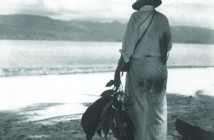DREAMS, CHARETTES AND HOMETOWN PLANS
On June 25, 1927, W. A. Forster was sworn in as South Miami’s first Mayor, and the City began its eight decade journey. In this last installment of our history series, author Donna Shelley, weighs in with her commentary on the more recent developments over the past twenty-plus years.
-jes
THE TRAINS ARE RUNNING (AGAIN)
May 20, 1983, marked the opening of the South Miami Metrorail Station. This elevated railway, designed to provide public transportation and alleviate vehicular traffic, imposed itself on the eyes and ears of those who lived along its route. The railway, a gray concrete overhead intrusion in the cerulean Florida sky, its station and parking garage (an homage to concrete) interpreted in an architectural style justly known as “Brutalism,” were sited opposite the western entrance of the city’s downtown. The train’s wheels, which could have been rubber were instead rendered in steel, like those used in subways. In the interest of saving costs, the residents have ever since been treated to the grinding and gnashing of steel-on-steel as the trains squeal to a stop in the station.
Regarded as an important ingredient in the city’s future prosperity, the opening of the Metrorail station was greeted with a marketing campaign created to bring attention to this small city just south of Coral Gables. Because the Metrorail tracks followed almost the same trajectory as the old Florida East Coast Railway, the campaign built on the obvious theme. “Always a Railroad Town” was the claim, as at the opening event, a calliope played and city officials donned railroad engineer’s caps for the opening event. South Miami was the only station on the route that had a viable downtown/commercial area in proximity to the station. At $866 million, Metrorail was the largest public works construction project in Dade County’s history at that time.
The Hometown Plan demonstration project on Dorn Avenue (59 Avenue) before the 1990s.The Metrorail and the FEC had more in common than their similar routes. Each in its own way served to create a formidable barrier, dividing the city east and west along Dixie Highway.
The FEC brought prosperity to the fledgling pioneer village (Larkins) turned city. The early settlers moved their base of operations to the site of the railway to take advantage of a reliable way to get their goods to market and to build commerce in their new community.
The presence of the Metrorail in South Miami helped to spawn dreams, charettes, and a multi-million dollar shopping/hospitality center, called The Bakery Centre, that met with utter failure. In an effort to comprehensively address the municipality’s future planning direction, city government convened a community charette in November 1992. An overlay ordinance designed to govern future development within the study area was adopted by the city commission the following year.
The Hometown Plan demonstration project on Dorn Avenue (59 Avenue) after the 1990s.A NEW VISION
The Hometown Plan was completed by Dover, Kohl & Partners in January 1993. It envisioned a future for South Miami’s downtown that strove to keep traditional small town design values with people-friendly, pedestrian-oriented public spaces. It stressed a full mix of uses, including residential; proper setbacks; an approach to parking that would encourage development; and incentives to attract development. Among other goals identified were: improved pedestrian access on Sunset Drive; improved Metrorail access; and the enhancement of the appearance of US 1 as a signature boulevard through South Miami.
The Hometown Plan indeed created a hometown and not an ultra-urban downtown. Narrow sidewalks and wide streets were modified to encourage slower through-traffic and wider landscaped sidewalks were created to attract people to the downtown, encouraging al fresco dining. The planning ordinance addressed limitations on building heights and highlighted preferred architectural designs such as covered arcades and curb appeal. In response to the need for infrastructure parking in the area, a municipal garage was recently built.
Art In Public Places installation of John Henry’s Pacienza at the South Miami Metrorail station and parking garage.The first project built in accordance with the Hometown Plan. The Shops at Sunset Place, designed by the local architectural firm of Wolfberg, Alvarez and Partners, was opened January 22, 1999. It was followed by the Amster Building located adjacent to a trio of designated historic buildings on US 1 and Sunset, and Plaza 57, an office and retail building at 57th Court–both projects complied with the basic tenets of the Hometown Plan. One major project on the boards that was not brought to fruition was the First National Bank of South Florida’s concept to build a large mixed use complex on Sunset Drive and 73rd and 74th Streets. It hasn’t been realized for a variety of reasons, not the least of which was the general downturn of the housing market nationwide.
Hometown Plan Area 2, also developed by Dover, Kohl & Partners, is a study that addresses the neighborhood west of US1. Many of the same goals from the downtown plan are incorporated into Plan 2, including narrowed travel lanes, wider sidewalks, landscaping, and encouraging redevelopment with buildings sited close to the street along Sunset Drive. The subsequent master plan included transit-oriented development, protection for historic structures and pedestrian improvements to the streets and commercial buildings. The 1994 charette proposed a renewed, sustainable community of strong traditional neighborhoods that could be the envy of the region.
HOMETOWN STATION
Hometown Station was a live-work project envisioned for siting near the Metrorail station (Hometown Plan Area 2) that entailed wrapping the station’s parking garage with four story liner buildings and capping the garage with a courtyard and apartment building. The development was to make the Metrorail site a more welcoming, viable, and functioning public space–one which would connect to its surroundings and the community. The development was to be built via investments from the Miami-Dade Transit Agency, the City of South Miami, Community Redevelopment Agency and others in order to revitalize the area.
In December 1998, the Board of County Commissioners received one bid via a competitive request-for-proposal, and in 1999 the Board awarded a lease for the project to prominent businessman Raul P. Masvidal’s Hometown Station, Ltd. The lease began in 2001 and work commenced on Phase I which was the refurbishment of the existing garage; three other phases were planned. In 2005-6, Delant Construction began to clear the site for Phase II.
The Shops at Sunset Place.The project called for an office building in Phase II, ground floor level retail space in Phase III, and an apartment building in Phase IV. According to Dover, Kohl & Partners, the Hometown Station would add, “New round-the-clock occupants and put a whole new human face on the station.” The planners envisioned a project that would bind together and complement the existing garage and platform with elements that would, “Help change the station into a unified, urbane place.”
In 2002-3, the Miami-Dade Housing Authority chose the South Miami Metrorail site for its new $27 million, 157,000-square-foot office complex; Mr. Masvidal’s company was awarded the lease agreement. This was to be the office building slated for Hometown Station’s Phase II (scheduled to begin in 2004). Much controversy ensued concerning the MDHA’s proposed building, beginning with the source of the initial $5 million funding for the project– surtax money that was earmarked for low-income housing—
South Miami Hometown Station artist rendering.and continuing with an outcry over a stripped-down redesign by Arquitectonica that some leaders felt eliminated much of the charm of the original Dover-Kohl concept. Delays, site infrastructure issues and changes were alleged by both Miami-Dade County and Hometown Station, Ltd., which resulted in the county’s cancellation of the entire project and ongoing legal hurdles for Raul Masvidal.
As the battle over Hometown Station was waged and ultimately lost, the residents of South Miami were left with a barren plot of county-owned land surrounded by Jersey barriers and green construction fencing, punctuated by brooding parking garages.
Eight long years later, the city was able to carve out 17,000 square feet for a passive park through a $1 per annum lease agreement with the county. Paciencia Park was formally opened in a ribbon-cutting ceremony on November 24, 2009, complete with John Henry’s sculpture, “Paciencia.”
To date, two mixed-use projects in the transit-oriented district have been completed: the Valencia Apartments and Red Road Commons. Little has happened to make the Hometown Station dream a reality.
While plans and proposals for an improved area around the Metrorail gather dust, the concrete station continues to dominate the landscape, the city continues to be divided by the railway and the thundering vehicular traffic on US1, and South Miami continues to wait for a better day.
Recent developments: (Top left) Plaza 57, (Top right) The Amster Building, (Bottom left) Valencia Apartments, (Bottom right) Red Road Commons.




1 Comment
I wish to thank the publisher of this magazine,John Edward Smith and his excellent writer,Donna Shelley, for an extremely interesting and informative series on the history of South Miami.
I have saved every one of these issues and appreciate how much I have learned .
Pam Lahiff Chair Historic Preservation Board City of South Miami